Small Intestine: Internal Hernia
Definitions
Definition
- Herniation Through an Opening in the Peritoneum or Mesentery
- Opening Can Be Congenital or Acquired
Types
- Paraduodenal
- Historically the Most Common (53%) – Not Anymore Given Frequency of Newer Laparoscopic Procedures
- Foramen of Winslow
- Peri-Cecal: Herniation in the Pericecal Fossa
- Inter-Sigmoid: Herniation Through the Intersigmoid Fossa (Often Easily Reducible)
- Debated if it is a True Aperture/Hernia
- Supravesical: Herniation into the Space of Retzius (Can Be Anterior or Posterior to the Bladder)
- Trans-Omental: Herniation Through the Greater or Lesser Omentum
- Trans-Mesenteric: Herniation Through a Complete Defect in the Mesentery
- Either from a Congenital Defect or from a Surgical Defect (Retrocolic Roux-en-Y)
- Retro-Anastomotic: Related to a Surgical Anastomosis
- Risk After Roux-en-Y Gastric Bypass: 3-5%
- Risk After Laparoscopic Colorectal Surgery: 0.65%
Paraduodenal Hernias
- Left Paraduodenal Hernia: Herniation Through Landzert’s Fossa
- Most Common (75%)
- Right Paraduodenal Hernia: Herniation Through Waldeyer’s Fossa
Sigmoid-Related Hernias
- Inter-Sigmoid: Herniation Through the Inter-Sigmoid Fossa (Often Easily Reducible)
- Debated if it is a True Aperture/Hernia
- Trans-Mesosigmoid: Herniation Through a Complete Defect in the Sigmoid Mesocolon
- Intra-Mesosigmoid: Herniation into an Incomplete Defect in the Sigmoid Mesocolon Through Only a Single Layer with the Sac in the Sigmoid Mesocolon (Most Commonly the Left)
Mesenteric Defects After a Roux-en-Y Gastric Bypass
- Petersen’s Space – Mesenteric Defect Between the Roux Limb Mesentery & Transverse Mesocolon
- Brolin’s Space (Mesojejunal Window) – Mesenteric Defect at the Jejunojejunostomy
- Transverse Mesocolon Defect
- Only Present After Retrocolic Procedures

Sites of Internal Hernia: Left Paraduodenal Hernia (1a); Right Paraduodenal Hernia (1b); Foramen of Winslow Hernia (2); Pericecal Hernia (3); Sigmoid-Related Hernia (4); Transmesenteric Hernia (5); Transomental Hernia (6); Supravesical Hernia (7) 1

Left Paraduodenal Hernia 2
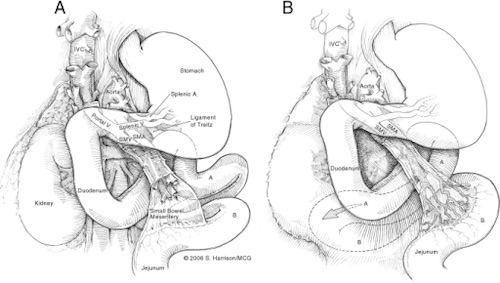
Right Paraduodenal Hernia; (A) Normal Anatomy, (B) Right Paraduodenal Hernia 3
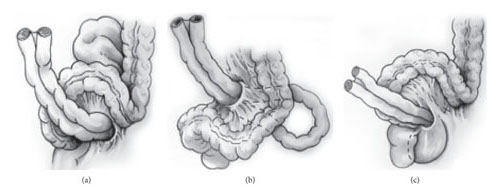
Sigmoid-Related Hernias; (a) Intersigmoid, (b) Trans-Mesosigmoid, (c) Intra-Mesosigmoid 4
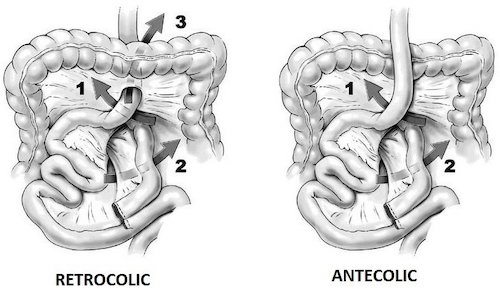
Mesenteric Defects After Roux-en-Y Gastric Bypass; (1) Petersen’s Space, (2) Brolin’s Space, (3) Transverse Mesocolic Window (Only in Retrocolic Bypass) 5
Congenital Anatomic Defects
Landzert’s Fossa
- Present in 2% of the Population
- Located Behind the Fourth Portion of the Duodenum
- Formed by the Mesenteric Fold from the IMV & Left Colic Artery
Waldeyer’s Fossa
- Present in < 1% of the Population
- Located Under the Third Portion of the Duodenum
- Formed by the Mesenteric Fold from the SMA
Foramen of Winslow (Epiploic/Omental Foramen)
- Communication Between the Greater Sac & Lesser Sac
- Anteriorly Bordered by the Hepatoduodenal Ligament
Pericecal Fossa
- Located Behind the Cecum/Ascending Colon
- 4-Subtypes: Ileocolic, Ileocecal, Retrocecal, & Paracecal
Intersigmoid Fossa
- Present in 65% of the Population
- Formed Between 2 Adjacent Sigmoid Segments & Their Mesentery
- Debated if it is a True Aperture
Supravesical Fossa
- Triangular Area Bounded by the Peritoneal Reflection Over the Dome of Bladder & Lateral Umbilical Folds
- Space of Retzius: Potential Space Below the Supravesical Fossa; Between Pubic Symphysis and Bladder
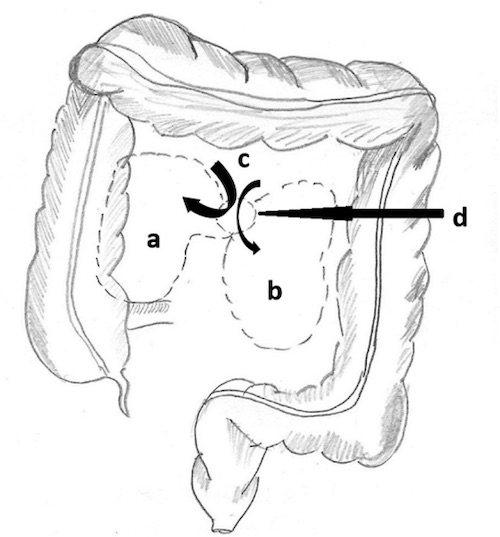
Paraduodenal Hernia Fossae; (a) Waldeyer’s Fossa, (b) Landzert’s Fossa, (c) Retroperitoneum, (d) Hernial Orifice 6

Foramen of Winslow 7

Pericecal Fossa 8
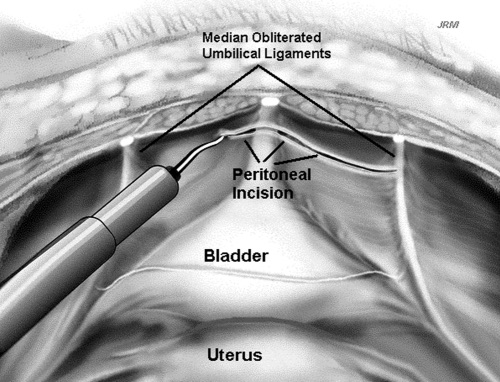
Incision into the Space of Retzius 9
Management
Presentation
- Can Be Asymptomatic
- Small Bowel Obstruction (SBO)
- Chronic Postprandial Pain
- Bowel Ischemia/Strangulation
Diagnosis
- Primarily Made by CT
- CT Findings:
- Small Bowel Obstruction
- Closed-Loop Obstruction
- Mesenteric “Swirling”
- Small Bowel Herniation into an Abnormal Location – Requires Sufficient Knowledge of Anatomic Spaces
- May Be Found Intraoperatively
Treatment
- Surgical Repair

Peterson’s Hernia; (A) AXR Showing SBO, (B) CT Showing Mesenteric Swirl Sign 10
References
- Lanzetta MM, Masserelli A, Addeo G, Cozzi D, Maggialetti N, Danti G, Bartolini L, Pradella S, Giovagnoni A, Miele V. Internal hernias: a difficult diagnostic challenge. Review of CT signs and clinical findings. Acta Biomed. 2019 Apr 24;90(5-S):20-37. (License: CC BY-4.0)
- Hassani KI, Aggouri Y, Laalim SA, Toughrai I, Mazaz K. Left paraduodenal hernia: A rare cause of acute abdomen. Pan Afr Med J. 2014 Mar 27;17:230. (License: CC BY-2.0)
- Bittner JG 4th, Edwards MA, Harrison SJ, Li K, Karmin PN, Mellinger JD. Laparoscopic repair of a right paraduodenal hernia. JSLS. 2009 Apr-Jun;13(2):242-9. (License: CC BY-NC-ND-3.0)
- Chiarini S, Ruscelli P, Cirocchi R, D’Andrea V, Sensi B, Santoro A, Corsi A, Zepponi F, Fedeli P, Gioia S. Intersigmoid Hernia: A Forgotten Diagnosis-A Systematic Review of the Literature over Anatomical, Diagnostic, Surgical, and Medicolegal Aspects. Emerg Med Int. 2020 Jun 1;2020:4891796. (License: CC BY-4.0)
- Kim, Y., & Crookes, P. F. (2014). Complications of Bariatric Surgery. In (Ed.), Essentials and Controversies in Bariatric Surgery. IntechOpen. (License: CC BY-3.0)
- Mehra R, Pujahari AK. Right paraduodenal hernia: report of two cases and review of literature. Gastroenterol Rep (Oxf). 2016 May;4(2):168-71. (License: CC BY-4.0)
- Wikimedia Commons. (License: CC BY-SA-3.0)
- Gray H. Anatomy of the Human Body (1918). Public Domain.
- Pikaart DP, Miklos JR, Moore RD. Laparoscopic removal of pubovaginal polypropylene tension-free tape slings. JSLS. 2006 Apr-Jun;10(2):220-5. (License: CC BY-NC-ND-3.0)
- Jang JS, Shin DG. A Peterson’s hernia and subsequent small bowel volvulus: surgical reconstruction utilizing transverse colon as a new Roux-en-Y limb – 1 case. J Korean Surg Soc. 2013 Dec;85(6):309-13. (License: CC BY-NC-3.0)